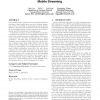Free Online Productivity Tools
i2Speak
i2Symbol
i2OCR
iTex2Img
iWeb2Print
iWeb2Shot
i2Type
iPdf2Split
iPdf2Merge
i2Bopomofo
i2Arabic
i2Style
i2Image
i2PDF
iLatex2Rtf
Sci2ools
NOSSDAV
2011
Springer
2011
Springer
A measurement study of resource utilization in internet mobile streaming
The pervasive usage of mobile devices and wireless networking support have enabled more and more Internet streaming services to all kinds of heterogeneous mobile devices. However, Internet mobile streaming services are challenged by the inherently limited on-device resources, device heterogeneity, and the bulk amount of streaming data. In this paper, focusing on resource utilization and streaming quality on mobile devices, we investigate 10 deployed Internet mobile streaming services that employ client-server, client-proxy-server, and P2P architectures from a client’s perspective. We find that (1) existing Internet mobile streaming services mainly use the client-server architecture and commonly adopt burst traffic delivery that can save battery power consumption on mobile devices; (2) to deal with device heterogeneity, some streaming services have already utilized intermediate nodes (often the user’s home computer) for online transcoding with a client-proxy-server architecture, b...
Battery Power Consumption | Client Proxy | Client Server Architecture | Computer Networks | NOSSDAV 2011 |
| Added | 16 Sep 2011 |
| Updated | 16 Sep 2011 |
| Type | Journal |
| Year | 2011 |
| Where | NOSSDAV |
| Authors | Yao Liu, Fei Li, Lei Guo, Songqing Chen |
Comments (0)

